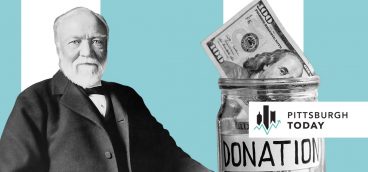How Do We Attract People to Pittsburgh?

David Feehan, president of Civitas Consultants in Maryland, is a recognized expert in downtown revitalization. For more than 50 years, his work has helped improve dozens of cities and neighborhoods in the United States and elsewhere, including Minneapolis, Detroit, Austin, Washington, D.C., Philadelphia and Pittsburgh. Pittsburgh Today spoke with him about ideas that might help increase population in Pittsburgh and southwestern Pennsylvania, a region that has lost some 400,000 people since 1969.
What are the key characteristics of places that are successful in attracting and retaining people?
A friend of mine said, “Cities are the stage on which we celebrate our communities, especially the downtowns. All of us working to save our cities are producers, directors and the cast of the production. And every day there is a new production.” Our job is to create a place where people want to be—places that are comfortable, inviting, exciting; places to go to socialize, eat, drink and be entertained. And sometimes the entertainment is just being there.
That’s the kind of shift cities have to make if they want to attract people. It’s a shift from just thinking about having jobs, affordable housing—the basics. Those are the table stakes. They just get you into the game. They don’t win you the hand.
When I talk to downtown organizations in other cities, I talk about the six M’s. The primary ones are maintenance, management and marketing. You have to have an organization adept at doing those things. Maintenance—the place has to be clean and safe. It may be safe, but if trash is strewn about and there’s graffiti everywhere, people won’t think it’s safe because they think no one is in charge. Marketing—you have to tell people you’re there and why they should come. Management decides what happens, who is producing, who is directing every day.
You have to do those things well or you’re not in the game.
The last three are moments, memories and magic. We remember special moments. They create memories and those memories are what keep people coming back. Pittsburgh isn’t Orlando. It’s a cold-weather city. It doesn’t have 30 million people a year coming to visit because Disney is there. You have to rely on repeat business. The way we do that is to create special moments and memories, and the moments have to have some magic to them. Those moments can be educational, experiential, aesthetic, escapist. When I first moved to Washington, D.C., in 2001, I was coming out of the metro station at Farragut Square and as I came to the top of the escalator, there was an elderly man playing the saxophone. He was extraordinary, almost as good as John Coltrane. It was a magical experience on my first day of work, getting out of the subway. It was something I never forgot.
What do you tell cities and towns about how to make themselves distinctive?
You want to be distinctive and appealing in ways that you end up as the number one choice when people are choosing where they are going to live or where they are going to move their business. There is no satisfaction in finishing second.
Cities need to develop an understanding of the “X factor.” If I say Hollywood, what do you think of? You probably say, movies. If I say Nashville, you probably say country music. If I say Vegas, you probably think gambling; Orlando, you probably say Disney. What would you say is the X factor for Pittsburgh? Pittsburgh has some wonderful things, but I don’t think it’s figured out how to package them. I don’t think Pittsburgh has an X factor.
You’ve written that one strategy for attracting and retaining people is to make a place more attractive to women. How is that done and why is that important?
We did a survey of some 130 women leaders. What would you say is the most hated aspect of coming to a downtown or business district from a woman’s point of view? Parking, especially parking garages. One woman said she hated the parking garages because they were dull, dirty, dark and dangerous. The second is the absence of clean, safe restrooms. Another question was, “What color is downtown?” Most women said gray. One of the reasons downtowns are like that is they were primarily designed by men. The people who control the professions that design downtowns—the architects, urban planners, real estate developers, construction people—are predominantly men and they are designing places that appeal to them.
Women today either make or influence most of the retail decisions, health care decisions and residential decisions. They are so influential in so many parts of the economy. They control more than half of the private wealth in this country. It’s not a matter of making the little lady happy. It’s realizing the immense power women have in the economy. That’s why downtowns and business districts and cities have to take women much more into account than they have.
You’ve done work in the Pittsburgh area. What are some ways the region might improve its ability to attract people from other places and convince them to settle here?
Pittsburgh is doing a lot of things right. It has some of the pillars in place that are going to help. Pittsburgh is recognized as a pioneer in medicine and health care. Carnegie Mellon is ranked as one of the top technology universities in the country. The revitalization of Downtown was absolutely essential. Downtown has become the anchor it needs to be.
But there doesn’t seem to be an overall strategy yet that is going to produce the people power that Pittsburgh needs to move forward. That is the key. When businesses look at places to locate, surveys show that a top consideration is whether they can get the people, the talent they need to build their business. That’s where Pittsburgh isn’t finishing Number One.
We’re not going to see a growing population if we only focus on whites and African Americans. We have to be more open to immigration and people coming from other countries. I would work on a strategy to attract Hispanics. They have a lot of characteristics that contribute to the economy and, I think, would match up well with Pittsburgh.
And Pittsburgh has to figure out that X factor—what is it you want Pittsburgh to be known for when it is competing against Nashville, Orlando, Austin and other places. If you ask someone what they think of when they think of Pittsburgh and they say, “the Steelers,” that’s all well and good, but the Steelers aren’t the reason people are going to move to Pittsburgh.





